Value Perception Analysis in the Brazilian Company of Research and Industrial Innovation
Abstract
1. Introduction
2. Literature Review
2.1. Perceived Value
- Functional value: capacity to deliver functional performance;
- Social value: positive or negative association with one or more specific social groups;
- Emotional value: the capacity to arouse feelings or affective states;
- Epistemic value: the capacity to arouse curiosity, offer novelty, and/or satisfy the desire for knowledge;
- Conditional value: value perceived as a result of a specific situation or set of circumstances that enhances the functional or social value.
2.2. Constructivist Multi-Criteria Decision Analysis
3. Research Methodology
3.1. Classification of the Research
3.2. Company Characterization
3.3. Methodology Stages
4. Self-Evaluation Model
4.1. Research Label and Actors
4.2. Brainstorming
4.3. Focus Group
4.4. Data Collection
4.4.1. Construction and Application of the Questionnaire
4.4.2. Data Tabulation and Application
5. Results and Discussion
5.1. Criteria and Sub-Criteria Analysis
5.1.1. Relationship with EMBRAPII
5.1.2. Agreement Signed
5.1.3. EMBRAPII’s Reputation
5.1.4. Technical Capacity
5.1.5. Ability to Adapt to Change
5.1.6. Overall Performance of the Criteria
6. Conclusions
Author Contributions
Funding
Institutional Review Board Statement
Informed Consent Statement
Data Availability Statement
Conflicts of Interest
Appendix A
| Criterion | Sub-Criterion | Excellent (L5) | Very Good (L4) | Good (L3) | Neutral (L2) | Bad (L1) | Median Position |
|---|---|---|---|---|---|---|---|
| 1. Relationship with EMBRAPII | 1.1 Credibility | 10 | 8 | 1 | 2 | 0 | N4 |
| 1.2 Transparency | 7 | 10 | 1 | 2 | 0 | N4 | |
| 1.3 Communication | 10 | 7 | 4 | 0 | 0 | N4 | |
| 1.4 Agility | 9 | 7 | 5 | 0 | 0 | N4 | |
| 2. Agreement signed | 2.1 Meeting the objectives of the agreement and alignment with your institution’s strategies | 7 | 11 | 2 | 1 | 0 | N4 |
| 2.2 Relevance of the results achieved with the agreement | 8 | 5 | 7 | 1 | 0 | N4 | |
| 2.3 Multiplier effect of resources offered by EMBRAPII | 10 | 8 | 2 | 0 | 0 | N4 | |
| 3. EMBRAPII’s reputation | 3.1 Recognition of EMBRAPII as a relevant institution in RD&I | 14 | 4 | 2 | 0 | 0 | N5 |
| 3.2 EMBRAPII’s image as a complement to public innovation policies/international programs | 12 | 6 | 2 | 0 | 0 | N5 | |
| 3.3 Media positioning | 5 | 7 | 5 | 2 | 0 | N4 | |
| 4. Technical capacity | 4.1 Quality of the materials delivered and the methods applied by EMBRAPII | 4 | 12 | 5 | 0 | 0 | N4 |
| 4.2 Technical staff efficiency | 10 | 8 | 1 | 1 | 0 | N4 | |
| 5. Ability to adapt to change | 5.1 Resilience to changes in the innovation environment | 4 | 13 | 1 | 1 | 0 | N4 |
| 5.2 Ability to present solutions in the face of changes in the innovation environment | 6 | 12 | 1 | 0 | 0 | N4 |
References
- Echeveste, M.E.S.; Rozenfeld, H.; de Castro Fettermann, D. Customizing Practices Based on the Frequency of Problems in New Product Development Process. Concurr. Eng. 2017, 25, 245–261. [Google Scholar] [CrossRef]
- Gumz, J.; Fettermann, D.C.; Sant’Anna, Â.M.O.; Tortorella, G.L. Social Influence as a Major Factor in Smart Meters’ Acceptance: Findings from Brazil. Results Eng. 2022, 15, 100510. [Google Scholar] [CrossRef]
- Brower, J.; Mahajan, V. Driven to Be Good: A Stakeholder Theory Perspective on the Drivers of Corporate Social Performance. J. Bus. Ethics 2013, 117, 313–331. [Google Scholar] [CrossRef]
- Fettermann, D.C.; Borriello, A.; Pellegrini, A.; Cavalcante, C.G.; Rose, J.M.; Burke, P.F. Getting Smarter about Household Energy: The Who and What of Demand for Smart Meters. Build. Res. Inf. 2021, 49, 100–112. [Google Scholar] [CrossRef]
- Pies, I.; Beckmann, M.; Hielscher, S. Value Creation, Management Competencies, and Global Corporate Citizenship: An Ordonomic Approach to Business Ethics in the Age of Globalization. J. Bus. Ethics 2010, 94, 265–278. [Google Scholar] [CrossRef]
- Fettermann, D.C.; Echeveste, M.E.S.; Tortorella, G.L. The Benchmarking of the Use of Toolkit for Mass Customization in the Automobile Industry. Benchmarking Int. J. 2017, 24, 1767–1783. [Google Scholar] [CrossRef]
- Ferrell, O.C.; Hartline, M.D.; Hochstein, B.W. Marketing Strategy: Text and Cases, 8th ed.; Cengage Learning: Singapore, 2022. [Google Scholar]
- EMBRAPII. Frontpage. Available online: https://embrapii.org.br/ (accessed on 25 October 2023).
- EMBRAPII. Report 1st Semester 2023. Brasilia. 2023. Available online: https://embrapii.org.br/wp-content/images/2023/10/Relatorio-EMBRAPII-1SEM2023-21.09.pdf (accessed on 28 November 2023).
- Zeithaml, V.A. Consumer Perceptions of Price, Quality, and Value: A Means-End Model and Synthesis of Evidence. J. Mark 1988, 52, 2–22. [Google Scholar] [CrossRef]
- Woodruff, R.B. Customer Value: The next Source for Competitive Advantage. J. Acad. Mark Sci. 1997, 25, 139–153. [Google Scholar] [CrossRef]
- Sheth, J.N.; Newman, B.I.; Gross, B.L. Why We Buy What We Buy: A Theory of Consumption Values. J. Bus. Res. 1991, 22, 159–170. [Google Scholar] [CrossRef]
- Kotler, P.; Keller, K. Marketing Management, 14th ed.; Prentice Hall: Upper Saddle River, NJ, USA, 2011. [Google Scholar]
- Grönroos, C.; Ravald, A. Service as Business Logic: Implications for Value Creation and Marketing. J. Serv. Manag. 2011, 22, 5–22. [Google Scholar] [CrossRef]
- Ishizaka, A.; Nemery, P. Multi-Criteria Decision Analysis; Wiley: Hoboken, NJ, USA, 2013; ISBN 9781119974079. [Google Scholar]
- Więckowski, J.; Kizielewicz, B.; Shekhovtsov, A.; Sałabun, W. RANCOM: A novel approach to identifying criteria relevance based on inaccuracy expert judgments. Eng. Appl. Artif. Intell. 2023, 122, 106114. [Google Scholar] [CrossRef]
- Ensslin, L.; Dutra, A.; Ensslin, S.R.; Graziano, L.A.G.; Longaray, A.A. Using a Constructivist Multi-Criteria Decision Aid Model (MCDA-C) to Develop a Novel Approach to Self-Manage Motivation in Organizations. Axioms 2022, 11, 331. [Google Scholar] [CrossRef]
- Ensslin, S.R. A Incorporação Da Perspectiva Sistêmico-Sinergética Na Metodologia MCDA-Construtivista: Uma Ilustração de Implementação, Universidade Federal de Santa Catarina: Florianopolis. 2002. Available online: https://repositorio.ufsc.br/xmlui/handle/123456789/82357 (accessed on 28 November 2023).
- Silva, A.M. Metodologia Da Pesquisa, 2nd ed.; Editora da Universidade Estadual do Ceará: Fortaleza, Brazil, 2015. [Google Scholar]
- Gil, A. Como Elaborar Projetos de Pesquisa, 6th ed.; Editora Atlas: São Paulo, Brazil, 2018. [Google Scholar]
- Gerhardt, T.E.; Silveira, D.T. Métodos de Pesquisa, 1st ed.; Editora da UFRGS: Porto Alegre, Brazil, 2009. [Google Scholar]
- Yin, R.K. Case Study Research and Applications: Design and Methods, 6th ed.; SAGE Publications: Los Angeles, CA, USA, 2018. [Google Scholar]
- Ministério da Ciência, T.E.I. Management Contract. Brasilia. 2021. Available online: https://embrapii.org.br/wp-content/images/2021/12/NOVO-CONTRATO-DE-GESTA%CC%83O-EMBRAPII.pdf (accessed on 28 November 2023).
- EMBRAPII. Bylaws. Brazil, 2022; pp. 1–13. Available online: https://embrapii.org.br/wp-content/images/2023/08/Estatuto-Social-Registrado.pdf (accessed on 28 November 2023).
- Nunes, R.R. MyMCDA-C Decision. Available online: https://rafael.rabelo.org/?page_id=33 (accessed on 28 November 2023).
- Rodrigues, E.C.C. Metodologia Para Investigação da Percepção das Inovações na Usabilidade do Sistema Metroviário—Uma Abordagem Antropotecnológica; Universidade de Brasilia: Brasilia, Brazil, 2014; Available online: https://transportes.unb.br/index.php?option=com_phocadownload&view=category&id=6&Itemid=381 (accessed on 28 November 2023).
- Tezza, R.; Zamcopé, F.C.; Ensslin, L. A Metodologia Multicritério de Apoio à Decisão Construtivista Para a Identificação Eavaliação de Habilidades Para o Setor de Estamparia Têxtil. Rev. Gestão Produção Operações Sist. 2012, 1, 125. [Google Scholar] [CrossRef]
- EMBRAPII. Multiannual Report 2014–2019. Brasilia. 2020. Available online: https://embrapii.org.br/wp-content/images/2020/01/embrapii_2014-2019_2P.pdf (accessed on 20 November 2023).
- EMBRAPII. Report—1st Semester of 2020. Brasilia. 2020. Available online: https://embrapii.org.br/wp-content/images/2023/10/Relatorio_EMBRAPII_2020_1sem_VERSAO-FINAL-GN.pdf (accessed on 20 November 2023).
- EMBRAPII. EMBRAPII Q&A International Cooperation. 2022. Available online: https://embrapii.org.br/wp-content/images/2021/02/FAQ_Cooperac%CC%A7a%CC%83o-Internacional.pdf (accessed on 20 November 2023).

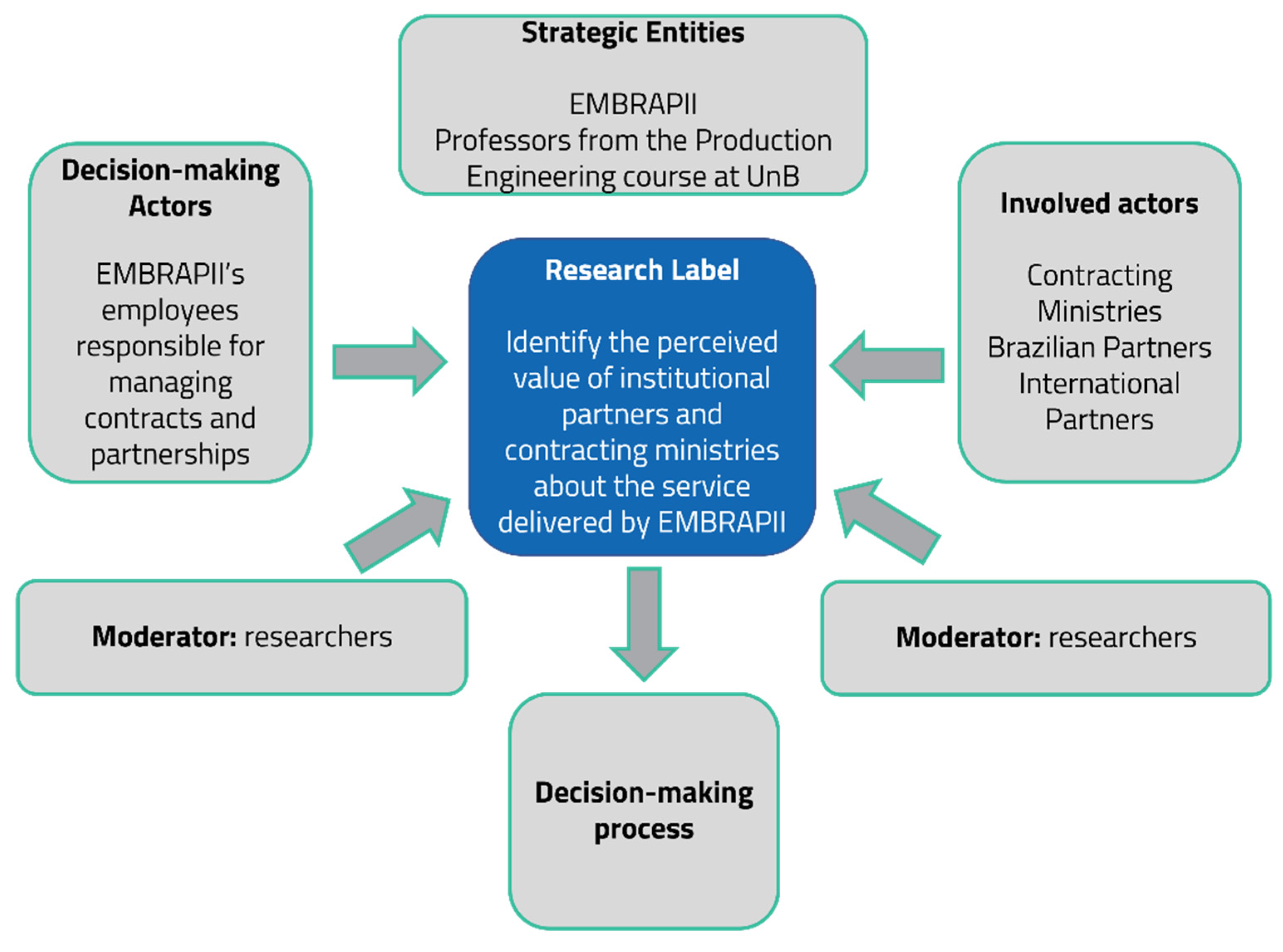
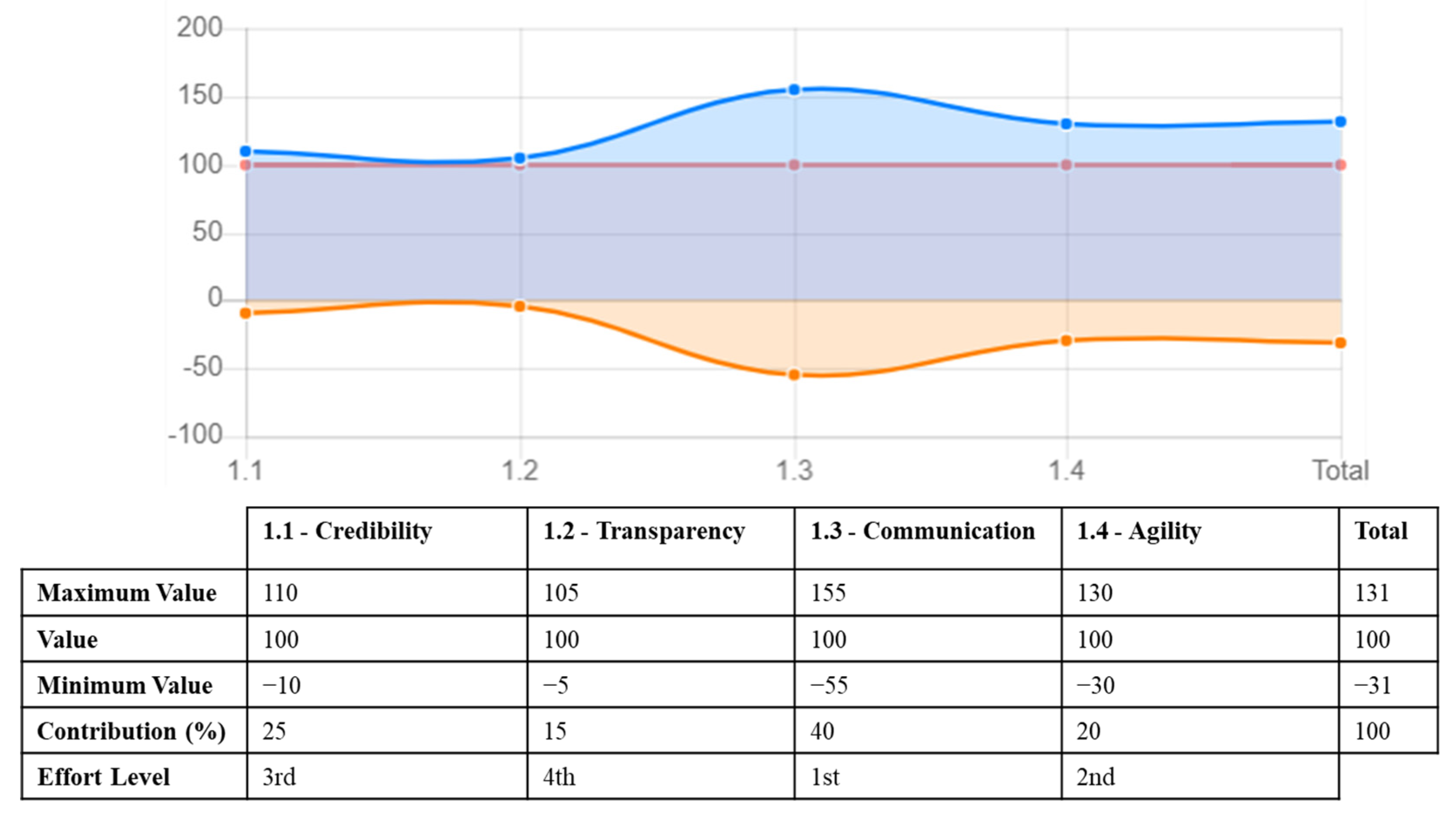
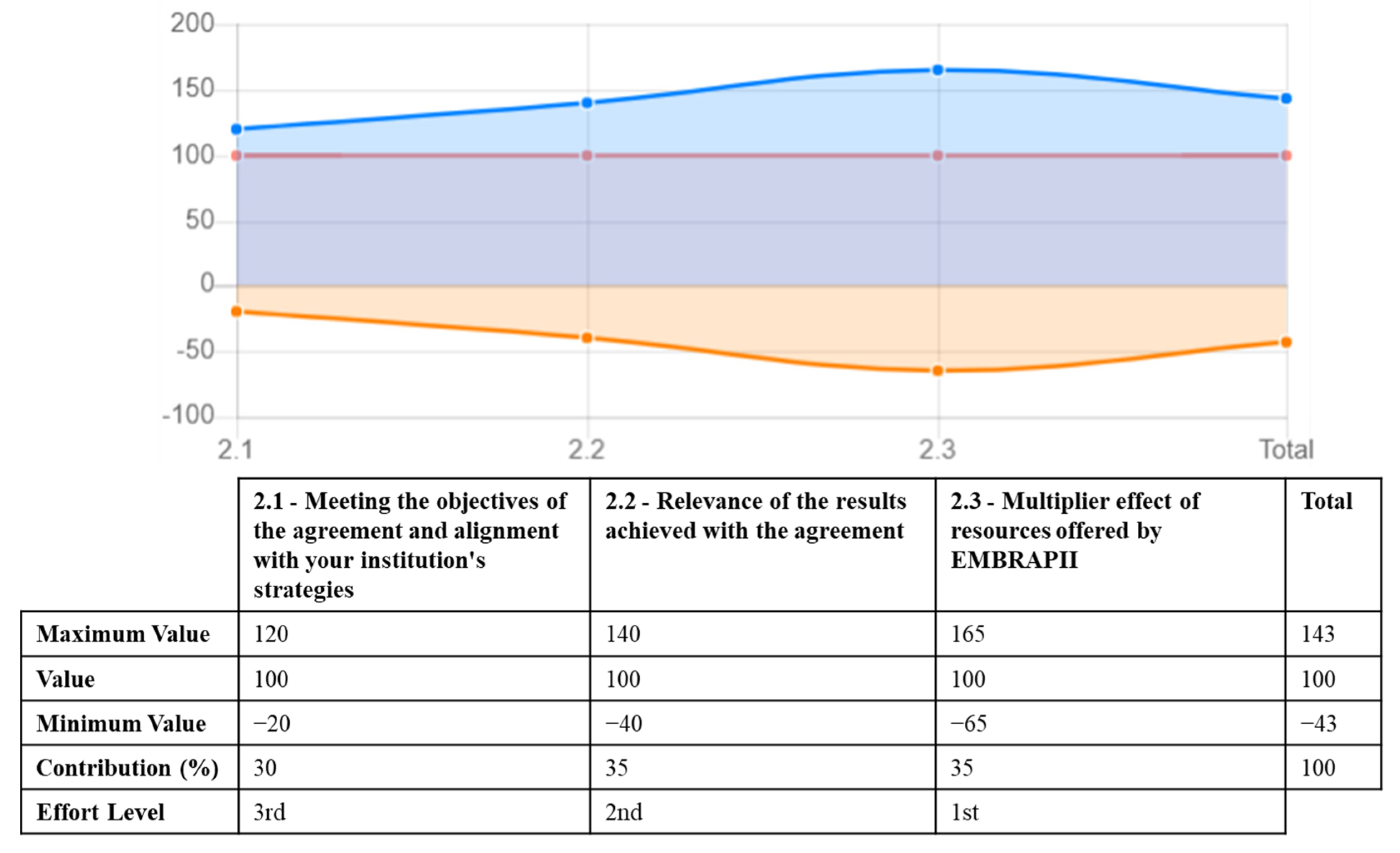
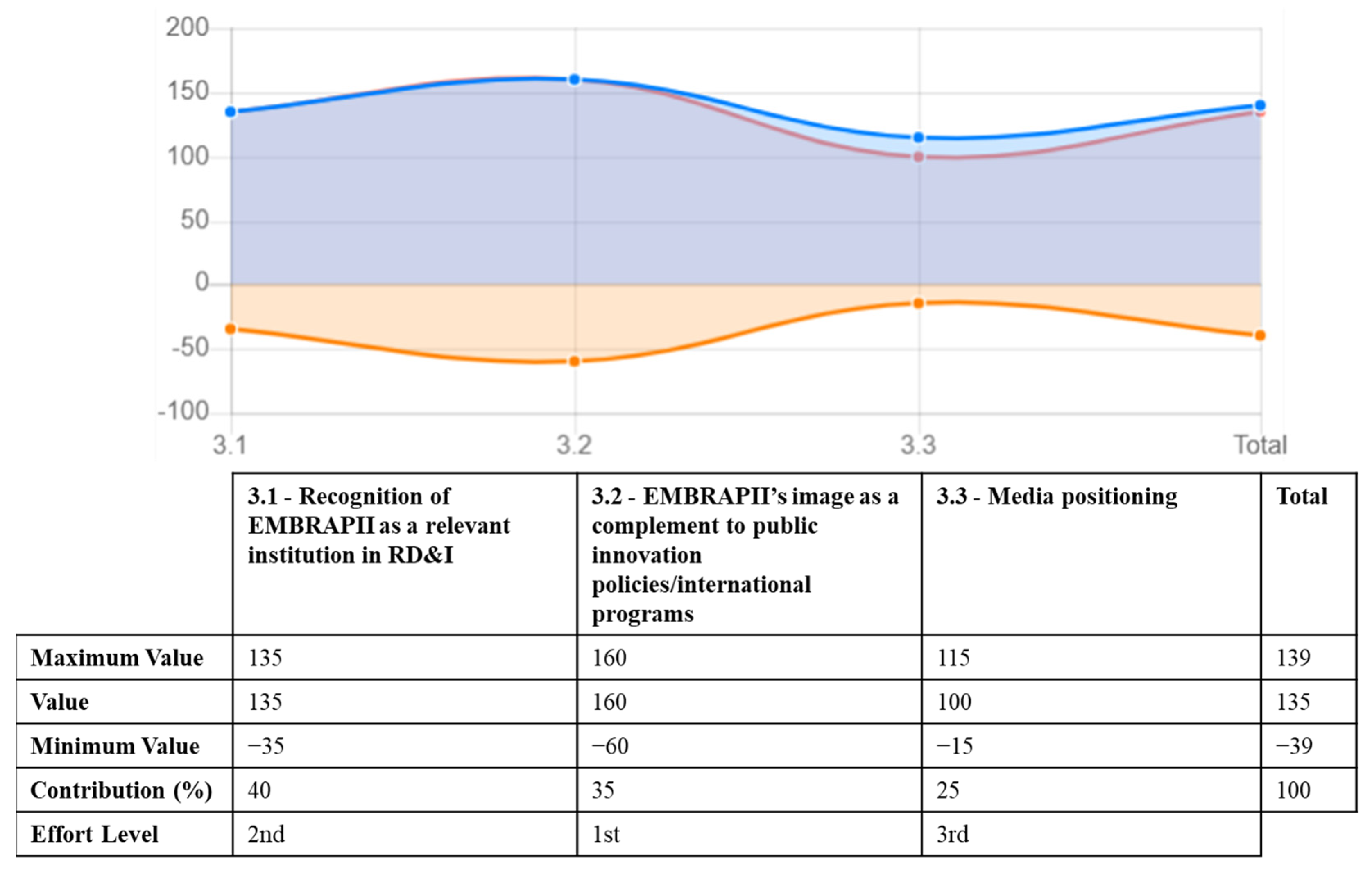
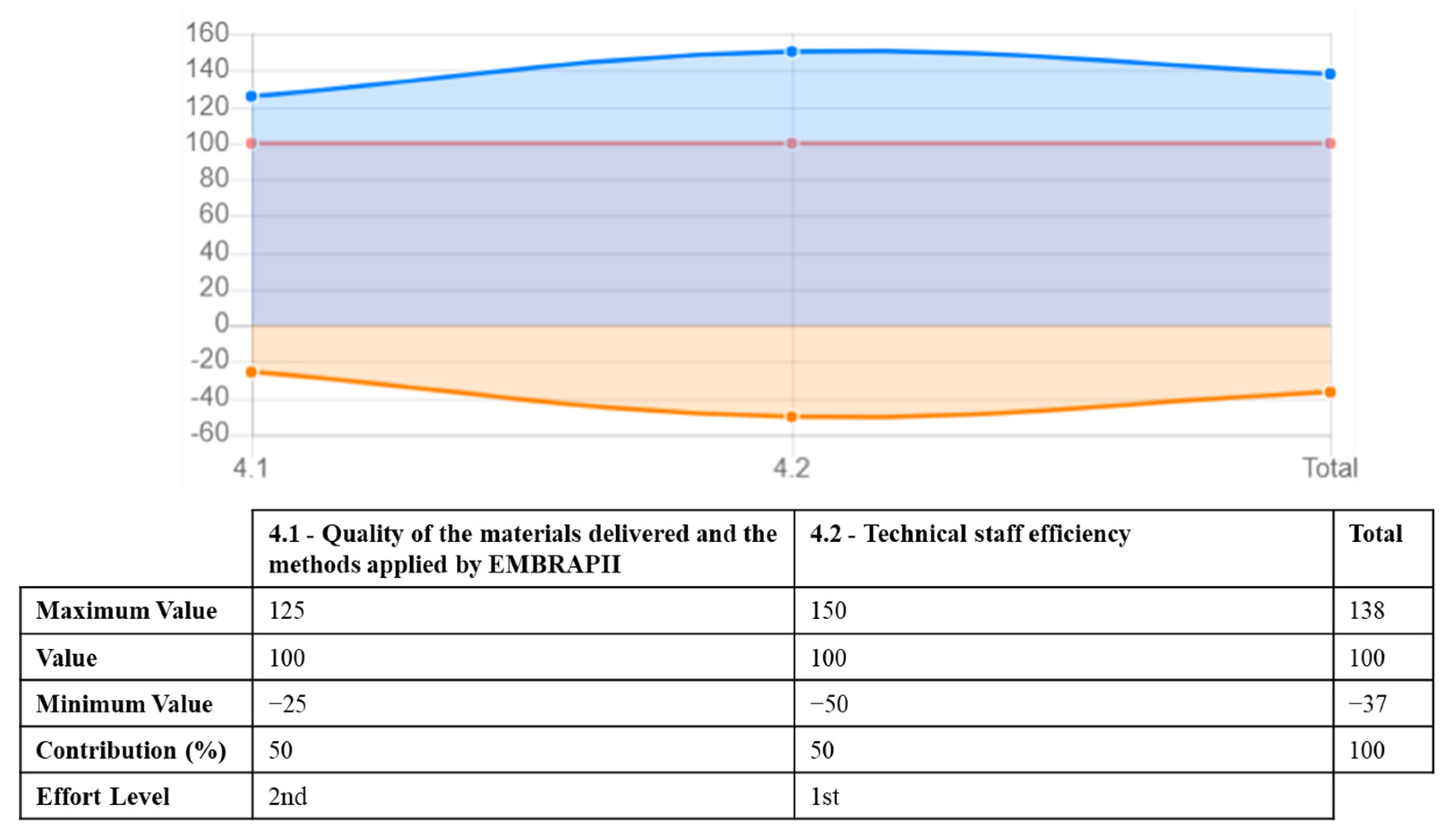
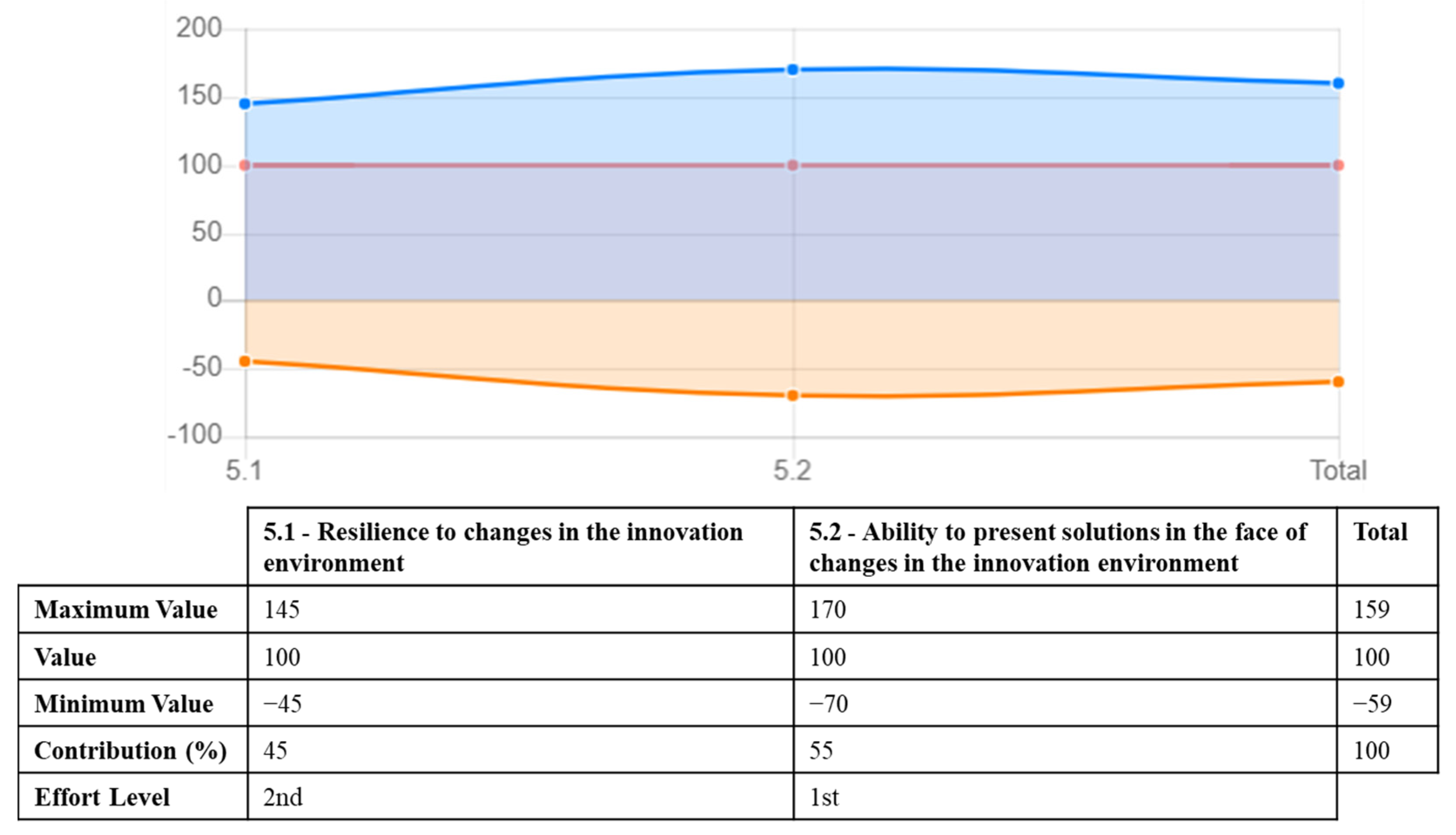
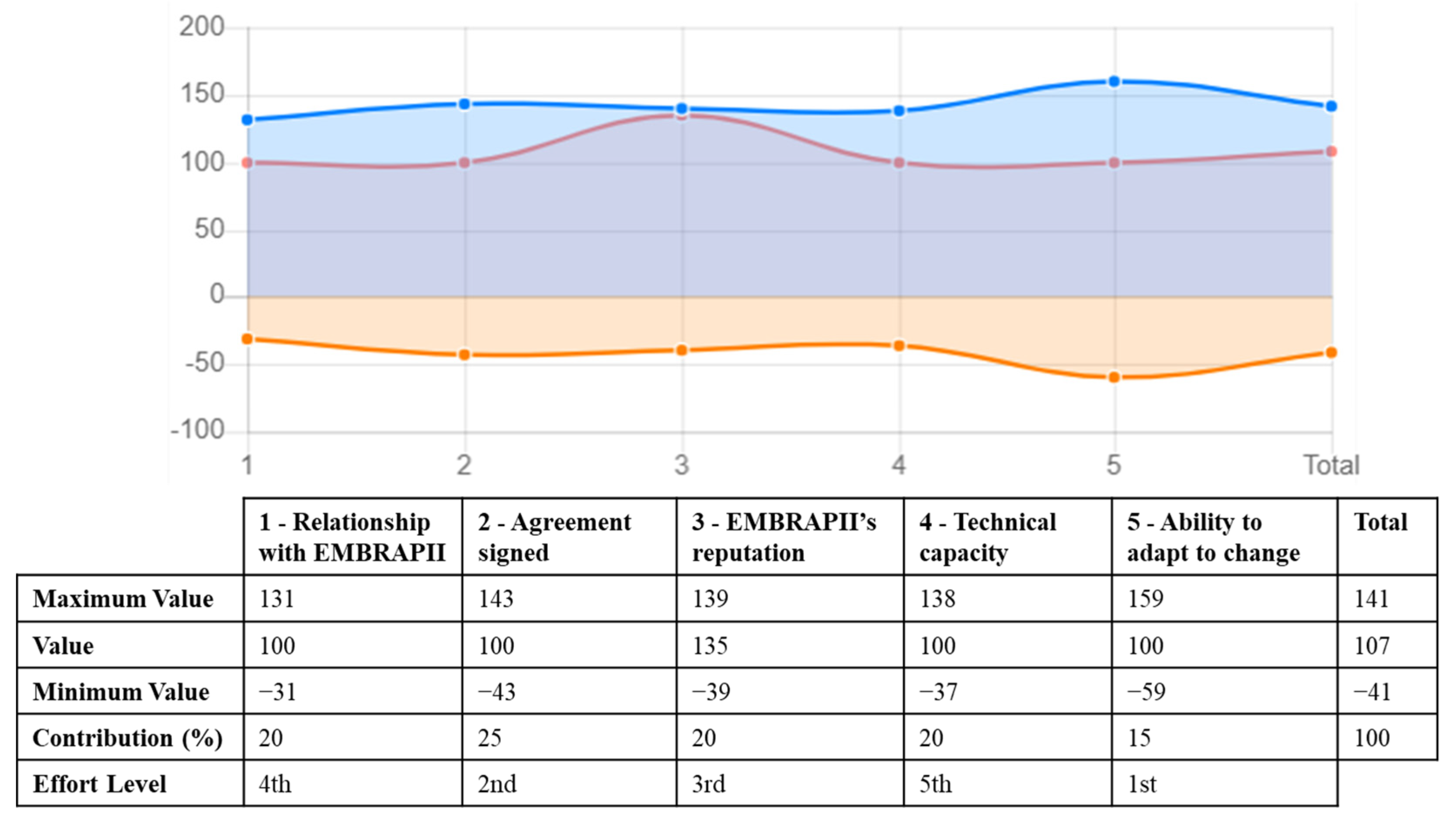
| Criterion (FPV) | Sub-Criterion (EPV) |
|---|---|
| 1. Relationship with EMBRAPII | 1.1 Credibility |
| 1.2 Transparency | |
| 1.3 Communication | |
| 1.4 Meeting deadlines | |
| 2. Agreement signed | 2.1 Meeting the objectives of the agreement and alignment with your institution’s strategies |
| 2.2 Relevance of the results achieved with the agreement | |
| 2.3 Multiplier effect of resources offered by EMBRAPII | |
| 2.4 Cost–benefit ratio | |
| 3. EMBRAPII’s reputation | 3.1 Recognition as a relevant institution |
| 3.2 EMBRAPII’s image as a complement to public innovation policies/international programs | |
| 3.3 Media positioning | |
| 4. Technical capacity | 4.1 Experience of the technical staff |
| 4.2 Staff skills | |
| 4.3 Technical staff efficiency | |
| 5. Ability to adapt to change | 5.1 Responding to changes in partnership requirements |
| 5.2 Resilience to changes in the innovation environment | |
| 5.3 Ability to present solutions in the face of changes in the innovation environment |
| # | Job and Position | Time in Position | Qualification |
|---|---|---|---|
| 1 | Coordinator in the Planning and Institutional Relations department and responsible for the national institutional partnerships of EMBRAPII | 6 years and 6 months | PhD in Science and Technology Policy at University of Sussex, England, and Post-doctorate in International Relations from the Universities of Oxford, England, and Princeton, USA |
| 2 | Executive assistant of EMBRAPII’s Board of Directors and responsible for the international institutional partnerships of EMBRAPII | 5 years and 10 months | Master’s Degree in Policy Studies in Education and PhD in Sociology of Knowledge, both from the Institute of Education of the University of London, England |
| 3 | Executive assistant of EMBRAPII’s Board of Directors and responsible for the agreement signed with the Brazilian Micro and Small Business Support Service -SEBRAE | 7 years and 1 month | PhD in Economics from the Fluminense Federal University, Brazil, and specialist in innovation policy and public policy management |
| 4 | Specialist in Industrial Innovation in the Planning and Institutional Relations department and responsible for the Priority Programs coordinated by EMBRAPII | 6 years and 4 months | PhD student in Science and Technology Policy at University of Campinas, Brazil, and specialist in public policy management |
| Criterion (FPV) | FPV Description | Sub-Criterion (EPV) | EPV Description |
|---|---|---|---|
| 1. Relationship with EMBRAPII | Relationship that your institution maintains with EMBRAPII from the partnership negotiations to the present day | 1.1 Credibility | The quality of inspiring belief |
| 1.2 Transparency | Availability of full information required and open communication regarding the progress of the agreement | ||
| 1.3 Communication | Effective exchange of information between EMBRAPII and your institution | ||
| 1.4 Agility | Ability to act in fast cycles of learning and decision-making | ||
| 2. Agreement signed | EMBRAPII’s compliance with the scope of the agreement and/or Memorandum of Understanding and its requirements | 2.1 Meeting the objectives of the agreement and alignment with your institution’s strategies | Fulfilment of the objectives set out in the contract |
| 2.2 Relevance of the results achieved with the agreement | Importance of the results achieved with EMBRAPII | ||
| 2.3 Multiplier effect of resources offered by EMBRAPII | Model of leverage of financial resources provided in projects | ||
| 3. EMBRAPII’s reputation | Opinion of your institution about EMBRAPII’s image in the media and in the innovation scenario | 3.1 Recognition of EMBRAPII as a relevant institution in RD&I | Seeing EMBRAPII as a relevant institution in the innovation scenario |
| 3.2 EMBRAPII’s image as a complement to public innovation policies/international programs | Perception of EMBRAPII as an important instrument to complement international innovation programs | ||
| 3.3 Media positioning | EMBRAPII’s image in the media, including social media | ||
| 4. Technical capacity | Technical capacity of the team located at EMBRAPII’s head office in Brasília-DF | 4.1 Quality of the materials delivered and the methods applied by EMBRAPII | Qualification and adequacy of what your institution receives |
| 4.2 Technical staff efficiency | Ability of the technical staff to perform what was planned in a productive way when applying the available resources | ||
| 5. Ability to adapt to change | EMBRAPII’s positioning in the face of changes that occur in Brazil and in the world in the field of innovation | 5.1 Resilience to changes in the innovation environment | EMBRAPII’s ability to adapt to new realities and new markets, while maintaining its operations and evolution |
| 5.2 Ability to present solutions in the face of changes in the innovation environment | How EMBRAPII shapes its business proposals to changes in the innovation environment and meets the needs of the moment |
| Criterion (FPV) | FPV Contribution Rate | Sub-Criterion (EPV) | EPV Contribution Rate | EPV Effort Level | FPV Effort Level | Overall Effort Level |
|---|---|---|---|---|---|---|
| 1. Relationship with EMBRAPII | 20% | 1.1 Credibility | 25% | 3rd | 4th | 13th |
| 1.2 Transparency | 15% | 4th | 14th | |||
| 1.3 Communication | 40% | 1st | 4th | |||
| 1.4 Agility | 20% | 2nd | 9th | |||
| 2. Agreement signed | 25% | 2.1 Meeting the objectives of the agreement and alignment with your institution’s strategies | 30% | 3rd | 2nd | 11th |
| 2.2 Relevance of the results achieved with the agreement | 35% | 2nd | 7th | |||
| 2.3 Multiplier effect of resources offered by EMBRAPII | 35% | 1st | 2nd | |||
| 3. EMBRAPII’s reputation | 20% | 3.1 Recognition of EMBRAPII as a relevant institution in RD&I | 40% | 2nd | 3rd | 8th |
| 3.2 EMBRAPII’s image as a complement to public innovation policies/international programs | 35% | 1st | 3rd | |||
| 3.3 Media positioning | 25% | 3rd | 12th | |||
| 4. Technical capacity | 20% | 4.1 Quality of the materials delivered and the methods applied by EMBRAPII | 50% | 2nd | 5th | 10th |
| 4.2 Technical staff efficiency | 50% | 1st | 5th | |||
| 5. Ability to adapt to change | 15% | 5.1 Resilience to changes in the innovation environment | 45% | 2nd | 1st | 6th |
| 5.2 Ability to present solutions in the face of changes in the innovation environment | 55% | 1st | 1st |
| Guiding Question | Answer Option | Impact Level | Reference Level |
|---|---|---|---|
| What is your perceived value of the service delivered by EMBRAPII regarding the following items? | Excellent | L5 | Great levels |
| Very good | L4 | ||
| Good | L3 | ||
| Neutral | L2 | Neutral | |
| Bad | L1 | Negative |
| Sub-Criterion (EPV) | Overall Effort Level | Contribution Rate | Position |
|---|---|---|---|
| 3.1 Recognition of EMBRAPII as a relevant institution in RD&I | 8th | 40% | 1st |
| 3.2 EMBRAPII’s image as a complement to public innovation policies/international programs | 3rd | 35% | 2nd |
| 2.3 Multiplier effect of resources offered by EMBRAPII | 2nd | 35% | 3rd |
| 4.2 Technical staff efficiency | 5th | 50% | 4th |
| 1.1 Credibility | 13th | 25% | 5th |
| 1.3 Communication | 4th | 40% | 6th |
| 1.4 Agility | 9th | 20% | 7th |
| 2.2 Relevance of the results achieved with the agreement | 7th | 35% | 8th |
| 2.1 Meeting the objectives of the agreement and alignment with your institution’s strategies | 11th | 30% | 9th |
| 1.2 Transparency | 14th | 15% | 10th |
| 5.2 Ability to present solutions in the face of changes in the innovation environment | 1st | 55% | 11th |
| 3.3 Media positioning | 12th | 25% | 12th |
| 5.1 Resilience to changes in the innovation environment | 6th | 45% | 13th |
| 4.1 Quality of the materials delivered and the methods applied by EMBRAPII | 10th | 50% | 14th |
Disclaimer/Publisher’s Note: The statements, opinions and data contained in all publications are solely those of the individual author(s) and contributor(s) and not of MDPI and/or the editor(s). MDPI and/or the editor(s) disclaim responsibility for any injury to people or property resulting from any ideas, methods, instructions or products referred to in the content. |
© 2024 by the authors. Licensee MDPI, Basel, Switzerland. This article is an open access article distributed under the terms and conditions of the Creative Commons Attribution (CC BY) license (https://creativecommons.org/licenses/by/4.0/).
Share and Cite
Moreira, I.E.; Fettermann, D.d.C.; Grubisic, V.V.F. Value Perception Analysis in the Brazilian Company of Research and Industrial Innovation. Knowledge 2024, 4, 171-193. https://doi.org/10.3390/knowledge4020009
Moreira IE, Fettermann DdC, Grubisic VVF. Value Perception Analysis in the Brazilian Company of Research and Industrial Innovation. Knowledge. 2024; 4(2):171-193. https://doi.org/10.3390/knowledge4020009
Chicago/Turabian StyleMoreira, Isabela Evora, Diego de Castro Fettermann, and Viviane Vasconcellos Ferreira Grubisic. 2024. "Value Perception Analysis in the Brazilian Company of Research and Industrial Innovation" Knowledge 4, no. 2: 171-193. https://doi.org/10.3390/knowledge4020009
APA StyleMoreira, I. E., Fettermann, D. d. C., & Grubisic, V. V. F. (2024). Value Perception Analysis in the Brazilian Company of Research and Industrial Innovation. Knowledge, 4(2), 171-193. https://doi.org/10.3390/knowledge4020009






